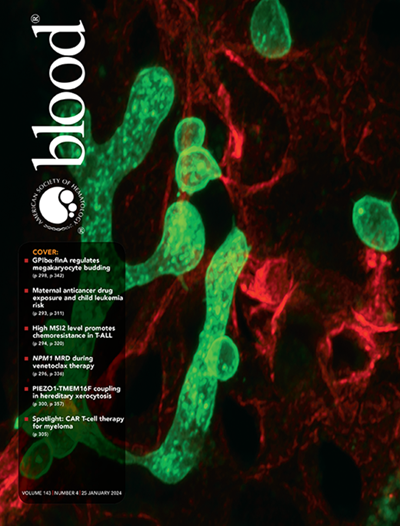白血病皮肤的免疫逃逸和髓外趋向性机制。
IF 23.1
1区 医学
Q1 HEMATOLOGY
引用次数: 0
摘要
导致急性髓性白血病(eAML)髓外趋向性的机制仍然不清楚,也没有针对这种实体的特异性治疗方法。由于eAML的长期生存率很低,因此有必要更深入地了解这种实体的免疫微环境和白血病表型。在这里,我们对10例皮肤和皮下组织分离的髓外疾病患者的23例eAML活检进行了大量和单细胞转录组分析。与正常的健康皮肤不同,我们发现白血病皮肤有严重的免疫浸润;在同种异体干细胞移植后髓外复发的病例中,大约90%的T/NK细胞是供体来源的。eaml相关的T细胞表达了T细胞衰竭的明确特征,这与骨髓复发中的白血病相关免疫群体不同(n=7),但与急性和慢性皮肤炎症有关。此外,HLA II类在7例白血病皮肤标本中的4例中下调,与eAML病例的免疫逃逸表型一致。髓外白血病细胞和骨髓驻留白血病细胞在8种归巢受体分子(ICAM1(编码CD54)、PECAM1 (CD31)、ITGA4、ITGA6、ITGAL、ITGB4、ITGA5和ITGAV)的表达上存在差异。通过ipilimumab和nivolumab连续免疫检查点阻断,从一个白血病皮肤病例中获得的系列样本显示局部和循环T细胞受体(TCR)序列之间始终高度重叠,这表明只有少数eaml相关的T细胞是白血病特异性的。我们的分析表明,eAML与白血病和T细胞基因表达谱的复杂变化有关,这表明有多种潜在的治疗靶向途径。本文章由计算机程序翻译,如有差异,请以英文原文为准。
Mechanisms of immune escape and extramedullary tropism in leukemia cutis.
The mechanisms that lead to extramedullary tropism of acute myeloid leukemia (eAML) remain obscure and no specific therapeutic approaches for this entity exist. As the long-term survival of eAML is poor, a deeper understanding of the immune microenvironment and leukemia phenotypes underlying this entity is warranted. Here, we performed bulk and single-cell transcriptome profiling of 23 eAML biopsies from 10 patients with isolated extramedullary disease in skin and subcutaneous tissue. Unlike normal healthy skin, we found leukemia cutis to be heavily immune-infiltrated; in cases of extramedullary relapse following allogeneic stem cell transplantation, >90% of T/NK cells were donor-derived. eAML-associated T cells expressed a clear signature of T cell exhaustion, dissimilar to leukemia-associated immune populations in bone marrow relapse (n=7), but related to acute and chronic skin inflammation. Further, HLA class II was down-regulated in 4 of 7 leukemia cutis specimens, consistent with an immune escape phenotype in cases of eAML. Extramedullary and bone marrow-resident leukemia cells differed with regard to the expression of 8 homing receptor molecules (ICAM1 (encoding CD54), PECAM1 (CD31), ITGA4, ITGA6, ITGAL, ITGB4, ITGA5, and ITGAV). Serial samples obtained from one leukemia cutis case throughout consecutive immune checkpoint blockade with ipilimumab followed by nivolumab showed a consistently high degree of overlap between local and circulating T cell receptor (TCR) sequences, suggesting that only a minority of eAML-associated T cells are leukemia-specific. Our analysis reveals eAML to associate with complex changes in leukemia and T cell gene expression profiles that suggest multiple potential avenues for therapeutic targeting.
求助全文
通过发布文献求助,成功后即可免费获取论文全文。
去求助
来源期刊

Blood
医学-血液学
CiteScore
23.60
自引率
3.90%
发文量
955
审稿时长
1 months
期刊介绍:
Blood, the official journal of the American Society of Hematology, published online and in print, provides an international forum for the publication of original articles describing basic laboratory, translational, and clinical investigations in hematology. Primary research articles will be published under the following scientific categories: Clinical Trials and Observations; Gene Therapy; Hematopoiesis and Stem Cells; Immunobiology and Immunotherapy scope; Myeloid Neoplasia; Lymphoid Neoplasia; Phagocytes, Granulocytes and Myelopoiesis; Platelets and Thrombopoiesis; Red Cells, Iron and Erythropoiesis; Thrombosis and Hemostasis; Transfusion Medicine; Transplantation; and Vascular Biology. Papers can be listed under more than one category as appropriate.
 求助内容:
求助内容: 应助结果提醒方式:
应助结果提醒方式:


